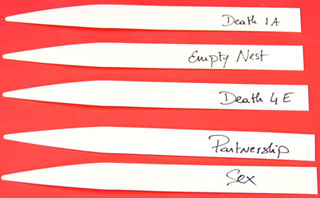REBLOG: scientists, designers, and artists will gather in New York to discuss how our lives could be transformed by recognizing scent as design, by Eva Wisten

Image and text source: Seed
On March 26, Parsons the New School for Design and MoMA, in collaboration with IFF, Seed, and Coty, will present Headspace: On Scent as Design. A one-day symposium on the conception, impact, and potential applications of scent, the event will gather leading thinkers, designers, scientists, artists, established perfumers as well as “accidental perfumers”—architects, designers, and chefs—to acknowledge scent as a new territory for design. Seed sat down with organizers Paola Antonelli, Véronique Ferval, Jamer Hunt, Jane Nisselson, and Laetitia Wolff to discuss why we tend to overlook the importance of scent, our increasingly antiseptic, smell-free lives, and how our lives could change when we begin to tap into the rich olfactory dimension of design.
What inspired Headspace?
The idea that led us to organize Headspace is that scent is not only a medium for design, but also a design form in its own right. Perfumers and scientists working on scent perform every time a design act. Sometimes it is good, sometimes mediocre. It can be very commercial, or more limited and idiosyncratic. Just like other forms of design, it is targeted to the goal at hand, whether the creation of a new clothing detergent with universal appeal or of a unique scent that will touch only a few dozen wrists. Just like other forms of design, it requires expertise and dedication, not to mention talent. We are therefore not advocating that any self-described designer should also feel free to tackle scent, but rather that designers should be aware of the spatial and perceptive potential of scent, and that perfumers should realize that they are engaged in design and take advantage of that knowledge.
Why is the smell experience of an object or an environment so often ignored or treated as less significant than the visual and, when it applies, aural, tactile or taste experience?
Scent happens both before and behind all other senses. Scents hit us directly through the limbic system; they are more pre-cognitive and emotional. For that reason, it’s harder for our mind to compute. Language doesn’t really seem up to the task of expressing all that scent means to us, or triggers within us. We ignore olfactive input because we have not been educated in a language with which to express any perceived gradations. Thus, we are still at the level of the “grunt,” limited to broad terms like good, bad, ugh, and sweet.
History has helped smell’s downfall, too. With the Enlightenment Era came a certain rationalization of our senses, where knowledge, culture, class, and intelligence were associated directly with our visual senses, whereas smell was associated with bodily fluids, dirt, and poverty. We seem to still be shaped by that dichotomy and we therefore miss out on one of our great cognitive gifts
An approach similar to the wine industry’s could motivate the public to acquire an education and a vocabulary to share their olfactive experiences. We have cultivated a sophisticated approach to flavor that makes us think we can really choose among twelve types of salt and twenty-five types of olive oils. There is no similar reciprocal relationship in the domain of smell that invites and rewards people to cultivate and pursue odor distinctions and experiences.
Social history has encouraged a discomfort with our beautifully functional nostrils. It is time to reclaim them!
Read the entire feature at Seed








